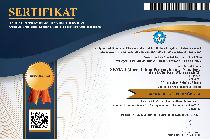Online Submissions
Registration and login are required to submit items online and to check the status of current submissions.
Author Guidelines
SEMAR JOURNAL ARTICLE WRITING FORMAT
GENERAL REQUIREMENTS
- Accepted articles are articles that have never been published in any journal in the form of or are not in accepted status for publication.
- Articles in the form of community service results that have relevance to the fields of human development and national competitiveness, local resource-based poverty alleviation, management of rural and coastal areas with local wisdom, economic development, entrepreneurship, cooperatives, creative industries, and MSMEs, environmentally sound technology development, health, nutrition, tropical diseases, and herbal medicines, arts, literature, and culture, as well as national integration and social harmony.
- The article is accompanied by a statement of originality from the author, stating that the article written is genuinely his work and does not contain plagiarism.
WRITING RULES
- Articles consist of 8-12 pages, typed with one space on A4 paper with Times New Roman font size 11 and using body notes. The article will be published using good Indonesian and English. More details see journal template!
- The article's structure consists of Title, Author Name, Abstract, Keywords, Introduction, Methods, Results and Discussion, and Conclusion. Acknowledgments (if any) and Bibliography.
- Terms of Article Writing:
- Title: consists of 15-20 words.
- Author's Name: written without title, accompanied by email address and institution name.
- Abstract is written in Indonesian or English, consists of 150-250 words and contains objectives of activities, methods and results or products.
- Key words are written in Indonesian or English, 3-5 words each.
- Introduction: contains conditions or problems that underlie or inspire the implementation of activities and the objectives of PKM activities.
- Method: describes the method used to solve the problem. Examples of methods: a) Community Education, for example, counselling aimed at increasing understanding and awareness, b) Diffusion of Science and Technology, for example activities that produce products for target groups, c) Training, for example, activities accompanied by demonstrations or pilots to produce specific skills, d) Mediation, activities that show PkM implementers as mediators in solving problems in society, e) Advocacy, for example, activities in the form of assistance to target groups. Also, describe the characteristics of the target group that is the partner of PKM activities.
- Results and Discussion: Explain the results or outcomes of PkM in the form of increased knowledge, skills or products. The results also express the level of achievement of the activity target. If in the form of objects, there needs to be an explanation of product specifications, advantages and disadvantages. Outcome writing must contain photos, tables, graphs, charts, drawings, etc. The discussion is sequential according to the order in the objectives and has been explained first. The discussion is accompanied by logical arguments that link the PkM results with theory, other PkM results or research results.
- Conclusion: written concisely but describing the substance of the PkM results and recommendations for future PkM activities.
- References: References is based on the APA 6th model (American Psychological Association). It is highly recommended to use Reference manager (end note, Mendeley, Zotero etc.) to facilitate editing and review.
Submission Preparation Checklist
As part of the submission process, authors are required to check off their submission's compliance with all of the following items, and submissions may be returned to authors that do not adhere to these guidelines.
- The submission has not been previously published, nor is it before another journal for consideration (or an explanation has been provided in Comments to the Editor).
- The submission file is in OpenOffice, Microsoft Word, RTF, or WordPerfect document file format.
- Where available, URLs for the references have been provided.
- The text is single-spaced; uses a 11-point font; times new romans, rather than underlining (except with URL addresses); and all illustrations, figures, and tables are placed within the text at the appropriate points, rather than at the end.
- The text adheres to the stylistic and bibliographic requirements outlined in the Author Guidelines, which is found in About the Journal.
- If submitting to a peer-reviewed section of the journal, the instructions in Ensuring a Blind Review have been followed.
Copyright Notice
Authors who publish with SEMAR journal agree to the following terms:
- Authors retain copyright and grant the SEMAR journal right of first publication with the work simultaneously licensed under Creative Commons Attribution License (CC BY 4.0) that allows others to share the work with an acknowledgment of the work's authorship and initial publication in this journal.
- Authors can enter into separate, additional contractual arrangements for the non-exclusive distribution of the published version of the work (e.g., post it to an institutional repository or edit it in a book), with an acknowledgment of its initial publication in this journal.
- Authors are permitted and encouraged to post their work online (e.g., in institutional repositories or on their website) before and during the submission process, as it can lead to productive exchanges, as well as earlier and greater citation of published work.
Privacy Statement
The names and email addresses entered in this journal site will be used exclusively for the stated purposes of this journal and will not be made available for any other purpose or to any other party.























